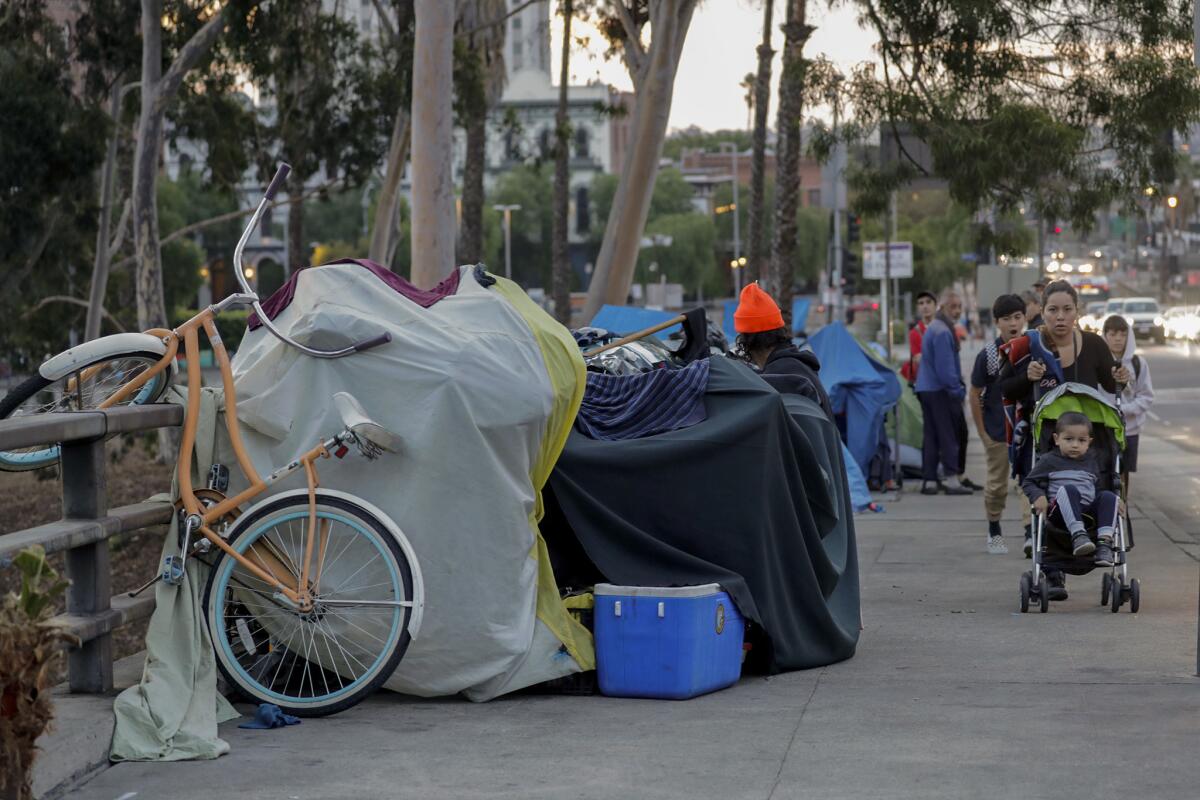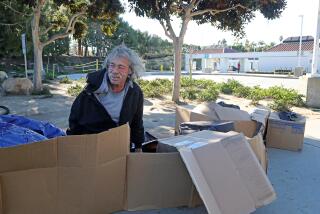Will L.A. impose new rules on sidewalk sleeping? Protests and debate erupt at City Hall

As surging numbers of people bed down on the streets of Los Angeles, politicians have faced radically different demands from residents and activists on how to react to the spread of ramshackle encampments.
Progressive activists have called to end the criminalization of homeless people and roll back rules that bar sleeping on sidewalks. Some community groups, in turn, want the city to ramp up enforcement of such rules to eliminate filth and blight.
At a meeting Tuesday at City Hall punctuated with shouting and hissing from the crowd, members of the Los Angeles City Council began to discuss how and whether to rewrite city rules about sidewalk sleeping — and came out with no clear answer.
City Councilman Mitch O’Farrell, who initiated the discussion, said L.A. needs to strike a balance between “the needs of people experiencing homelessness and people that we hear from every day who are understandably upset, frustrated and sometimes traumatized by the conditions they observe in many of our homeless encampments.”
“We must take an honest look at this catastrophe,” O’Farrell said, triggering yelling from the audience as he cited a “multifaceted set of conditions” in homeless encampments including addiction and mental health issues.
The hearing at City Hall came more than a month after city officials suggested drafting new rules that would bar people from sleeping on streets and sidewalks near schools, parks, child care and other targeted facilities, as well as a list of other prohibited areas.
At the meeting, several council members said they had concerns that the proposal was overreaching and misguided, arguing that it was the wrong step to take as the city faces a severe shortfall of shelter beds and housing for those who need it.
“We don’t have the luxury of dictating where tents can be when they’re growing by the thousands each year,” Councilman David Ryu said during the discussion, later adding that as council members, “we didn’t come here to find new ways to get sued.”
Looming over the debate is the question of whether any new restrictions would survive in court, after a federal ruling struck down restrictions on sidewalk sleeping in Boise, Idaho, last year. City attorneys said the proposed restrictions would nonetheless be permissible under the Boise ruling, a position vigorously disputed by some attorneys representing homeless people.
L.A. has a blanket ban on sidewalk sleeping on the books — which O’Farrell stressed is out of line with the Boise ruling — but has agreed to pull back on enforcing those rules at night after skid row residents sued the city years ago.
Under a key settlement, L.A. said that until more homeless housing was built, it would let people sleep on sidewalks from 9 p.m. to 6 a.m. if they stayed far enough from doorways and driveways. The rules can still be enforced during the day or in barred spots, but tents and bedrolls remain a common sight on sidewalks well after dawn as homelessness has risen.
City Atty. Mike Feuer has argued that the new proposal would strike a balance between the needs of homeless people and other residents who want safe and accessible public spaces. During Tuesday’s meeting, some council members described community alarm about encampments that force schoolchildren and other pedestrians into the street.
Councilman Bob Blumenfield, who represents part of the western San Fernando Valley, said the restrictions needed to be “more tailored” than the current proposal, but that L.A. needs to provide safe access to community amenities such as schools.
In his district, he said, teenagers going to Taft Charter High School walk into a busy street to avoid encampments lining a highway underpass, sometimes out of fear of someone “drugged out with needles in their arm” — words that drew booing from the crowd.
“That is a reality,” Blumenfield said, inviting those booing to go look for themselves. “Now, I don’t want to criminalize the homeless —”
“Yes you do!” someone shouted.
The proposed restrictions have been decried by homeless advocates who argued they would nearly banish homeless people from the city.
At one point, activists brought the meeting to the halt, yelling and eventually chanting, “Shame on you!” Venice activist David Busch, who is homeless, marched to the front of the chambers and shouted that “to even discuss this is disgusting!”
A Times analysis found that key parts of the plan, including restrictions near parks, schools, child care centers and major venues such as Staples Center, would put at least 26% of the city off limits for sidewalk sleeping. Homeless advocates argue that existing restrictions in parks — which cover 15% of the city — as well as around doorways and driveways would block out much more space.
“It makes no ethical or logical sense to place these high restrictions on where the unhoused can exist — especially when there are neither enough shelter beds nor housing units and when the need for basic resources isn’t met,” North Hollywood resident Mat Levitt told the council before the Tuesday discussion.
Councilman Marqueece Harris-Dawson said the city would not be able to uniformly enforce such rules, leading to “selective enforcement on selective people in selected neighborhoods.” He also denounced another part of the proposal that would ban people from obstructing sidewalks by acting in a way that would cause fear or lead a “reasonable person” to respond violently.
Police officers with training have misidentified threats and taken lives as a result, Harris-Dawson said. “The idea that we would extend this to everyday people, to me, is just completely unconscionable and defies common sense,” the councilman added.
O’Farrell said he would seek to eliminate that specific provision and alter others mentioned by Harris-Dawson when the proposal returns to his committee for more discussion. But he sounded dubious, as the debate wrapped up, about whether the council had the “appetite” to deal with the disputed law at all.
“That remains to be seen,” O’Farrell said.
More to Read
Sign up for Essential California
The most important California stories and recommendations in your inbox every morning.
You may occasionally receive promotional content from the Los Angeles Times.











